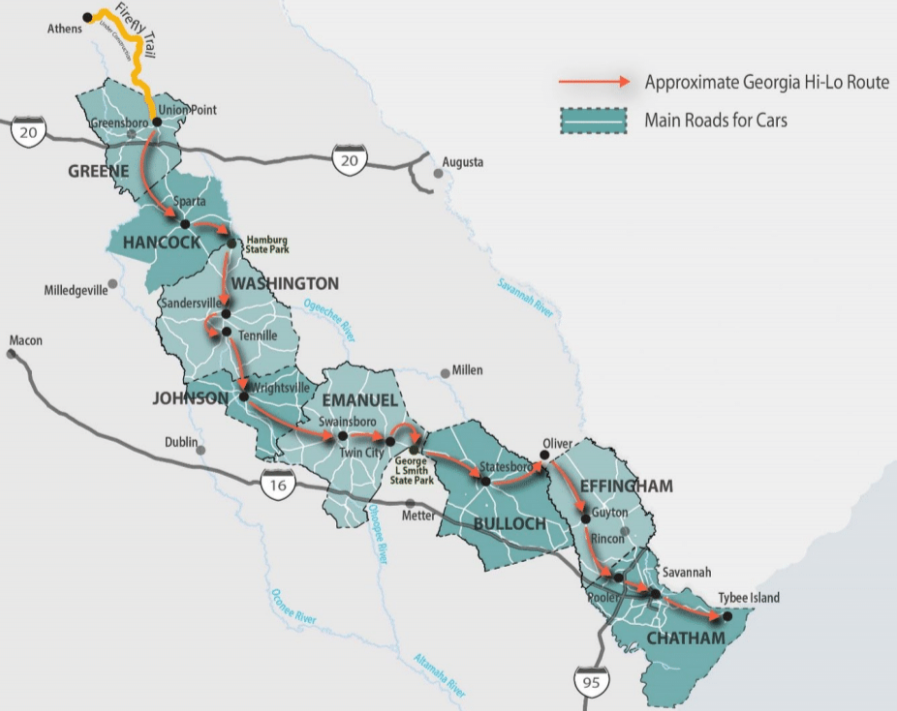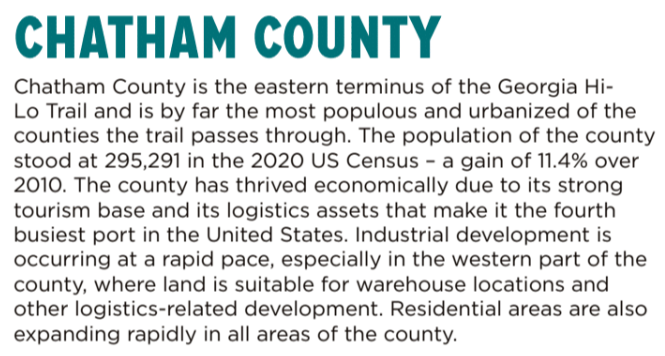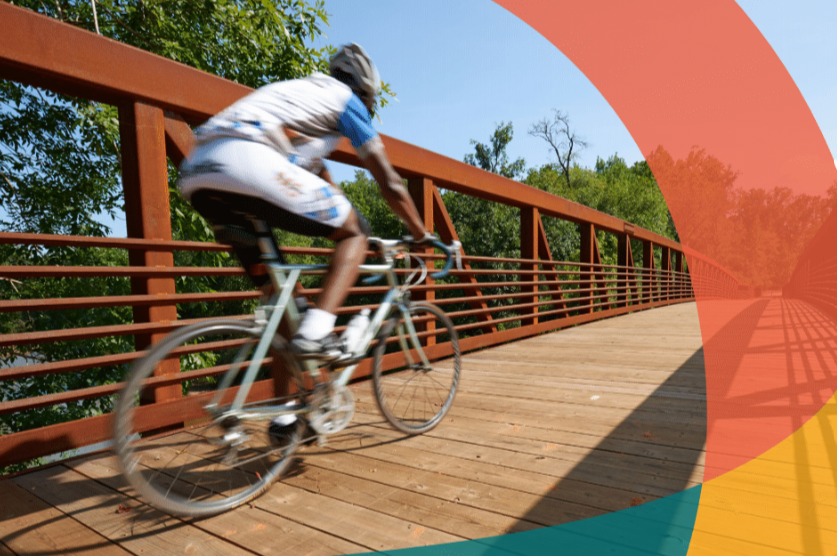By Brian Myers
CYCLISTS in the southeastern U.S. are rejoicing with the news of an extensive network of bike trails that are currently in development.
The Georgia Hi-Lo Trail will expand through eight counties, eventually connecting to the popular Firefly Trail in Athens, and aims to do the same with the newly approved Tide to Town urban trails in Savannah.
Upon its completion, the connected trails will span an estimated 250 miles, making it the longest connected paved trail network in the nation.
The project began its first phase earlier this month in Sandersville, Ga., where the official groundbreaking ceremony for the first phase was conducted. The not-for-profit entity that has worked for several years to bring the project to fruition, Georgia Hi-Lo Trail, Inc., held the celebratory event in conjunction with the community’s annual Sizzler 5K Trail Run and MTB race.
The excitement in the air was palpable and signaled a strong momentum that organizers are hopeful will continue as each phase of the trail system goes underway.
The official Hi-Lo Trail will be an estimated 211 miles, though its connection to the Firefly Trail to the north will give it the connectivity it needs to surpass Missouri’s famous Katy Trail, which extends east-to-west across the Show Me State for 239 miles.

Mary Charles Howard, Founder and Executive Director of Georgia Hi-Lo Trail, Inc., outlined the plans for the extensive and historic trail system in a recent interview with The Savannahian.
Hailing from the small Georgia town of Sandersville, Howard lived for a time in Athens where she “fell in love with the surrounding area’s trail system.”
“You never know how much you love and appreciate an amenity until you no longer have access to it,” she lamented when talking about her 2015 move from Athens back to her hometown.
With a love for biking, but now with a toddler in tow, Howard longed for the safe system of trails that Athens offered, but also the other ancillary benefits that accompanied it.
“These trails connect rural communities with each other. What are we going to be able to do to save these towns, other than bringing industry?” Howard asserted that the long trail systems in other parts of the U.S. “bring people back to small towns to invest in them.”
These investments, whether they’re breweries, eateries, or retail shops that pop up along the trails, not only give the trail patrons benefits, but also serve as a beacon for these communities to attract more residents.
“It’s less expensive to live in a small town,” she pointed out. “But without certain businesses, it can be hard to attract new people.”
Howard discussed how the trails lead to small towns being able to provide an “experience economy” for residents and visitors alike.
Combined with the connectivity to other smaller towns, the trail systems can be the real shot in the arm that a floundering town bypassed by the interstate program needs to survive and ultimately grow.
Local governments and the citizens that they represent have helped to spread the word and garner the support the trail needs as it spans multiple counties throughout dozens of municipal jurisdictions.

Howard acknowledges that getting so many different entities up to speed on the project and ultimately garnering their support has been a challenge at times, but one that she and other organizers have been proactive about meeting head on.
One of the biggest challenges has been educating concerned residents about who and what these trail systems bring to the communities that host them.
A few adjacent property owners have presented their concerns with their respective local governments, mostly worried about increases in crime. This is a mindset that has revealed itself nearly every time a trail system has been proposed, and is one that is patently false.
To overcome this false perception, Howard is adamant that local governments should be made aware not only of the benefits that these trials bring to their communities, but also the statistical proof that they are as safe as they are fun.
As with any recreational project, funding can also serve as a barrier. But Howard and the rest of the team serving on the not-for-profit have been hard at work to navigate this obstacle, too. A combination of federal and state grants and private donations have made the beginning stages possible.
The local communities that this trail will serve have also begun fundraising efforts. Earlier this summer, Statesboro committed $15,000 to the Hi-Lo Trail, raising it with joint public/private money. One segment of the trail will run through that community and on into Effingham County, where it will eventually lead to the Hostess City.
Howard told The Savannahian that, while some of the trail’s route has been mapped, the final route in parts has not been determined. She has high hopes that at some point it will extend beyond Savannah and spur onto the McQueen’s Island Trail on Tybee Island and add even more areas to explore.
For Savannah’s 4th District Alderman Nick Palumbo, the Hi-Lo Trail groundbreaking ceremony brings with it exciting news to coincide with the city’s own urban trail system that the elected official has helped to champion.
The Tide to Town system of urban trails might only be in its earliest stages, too, but it’s one that the Alderman maintains will carry with it a multitude of benefits when completed.
Aside from the physical and mental health benefits that Savannahians will enjoy with an urban trail system, Palumbo points out that these networks of paved pathways work to reconnect neighborhoods and bring people closer to other parts of their community.
Palumbo also sees the urban trail network as a way for community members citywide to get a major benefit afforded by tourism.
“This is a method of getting dollars out of downtown and into the rest of the community,” he explained after sharing that a good portion of local government monies toward the project stems from hotel/motel taxes.
“Statistics show that 70% of Savannah’s population live within one mile of the proposed trail,” he continued. As some locals will claim that the municipal government ignores the needs of the people that exist outside of the boundaries of downtown, Palumbo sees the trail system as a “physical, tangible product that virtually anyone can use.”
The elected official’s assessment here is correct. Similar trails in other communities across the U.S. have seen residents use these trails as a safer means to walk or ride a bicycle to and from work or school, take a leisurely stroll, or get in the two to three days of cardio activity the doctors recommend.
Palumbo says that Savannah’s system will maintain the expected levels of safety that its users want. The paved system will be well-lit and have a series of emergency call boxes that give an immediate connection to emergency services along the route.
He also revealed that funds have been allotted for the Park and Trees Department to keep up with maintenance, as well as budgetary line items for the Streets Department to maintain the pavement.
The Tide to Town project aligns with the City of Savannah’s Strategic Plan, one of its directives reading that 75% of the city’s neighborhoods will be connected with infrastructure that accommodates bikes and pedestrian traffic.
While the Georgia Hi-Lo Trail and Tide to Town are two separate entities, the connectivity that the Hi-Lo Trail will establish along its winding route gives locals a chance to venture further out into the Lowcountry and explore the charms of the hidden rural gems along a safe and strategically planned route to Athens.
The Hi-Lo Trail will be completed in multiple phases, and Howard expects the entire system to be finished by 2050. Enthusiasts who can’t wait have the option of participating in the 25th annual Athens to Savannah ride that begins in mid-October.
Those wanting a four-day ride along gravel routes begin their trek on October 17, while anyone seeking paved roadways start their journey on the following day.
The ride begins on the Firefly Trail and covers nearly 300 miles until it reaches Savannah. Registration for this year’s ride is now open.

